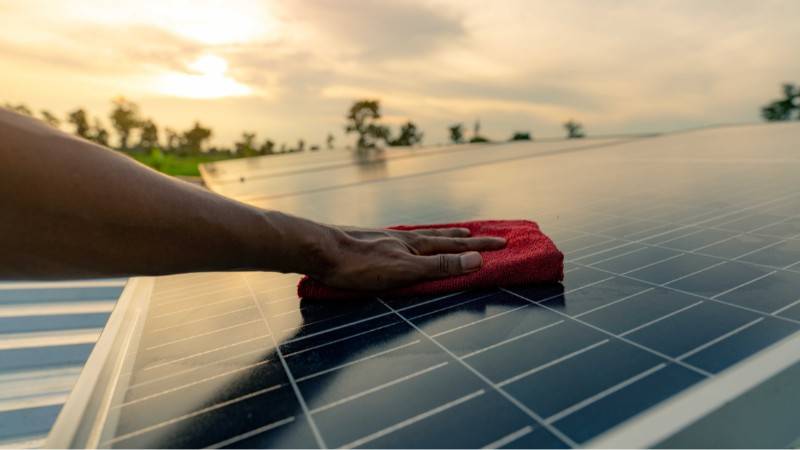One of the biggest concerns people have when considering a major investment in solar energy production is how long solar panels last. And that is one of the most important things you have to consider before you jump into this decision.
To help readers, I’ve collected technical information from researchers and solar installation companies. And then, I pulled in my own experience to share with you.
The reality is, just like your oil or gas boiler, solar panels degrade over time. But when you understand what modern technology can achieve and how some simple forward planning and maintenance tips help solar panels last longer, then the decision should become a lot easier.
How Long Do Solar Panels Last on Average?
To get a better understanding of how long modern solar panels will last, I spent a few hours researching information available at the National Renewable Energy Laboratory and on the websites of some of the largest solar panel manufacturers.
Average Lifespan
The average solar panel life expectancy these days is between 25 and 30 years. That is currently the lifespan of products, and you’ll also find that most manufacturers will back up those claims with a minimum productivity rate for different stages in the life of the panels.
See, the reality is that solar panels degrade over time, so it’s not like one day, 25 years from now, your panels will be faulty.
I have a neighbor who installed panels 30 years ago, and he still has them in use alongside an additional, more modern system. But those old 30-year-old solar panels are still working at 70% of their original performance.
This is a critical decision to make if you’re confused between buying and leasing solar panels.
Solar Panel Degradation Rate
While my neighbor’s solar panels might only have 70% of their original energy production performance after over 30 years, it’s important to note that the solar panel degradation rate of modern systems is much lower.
High-quality solar panels usually have a degradation rate of 0.5% per year. That means that after 20 years, the solar panel efficiency rate should still be 90% of what it originally was.
But this is something that you have to factor into your calculations when you want to figure out what the financial benefits are of installing solar panels.
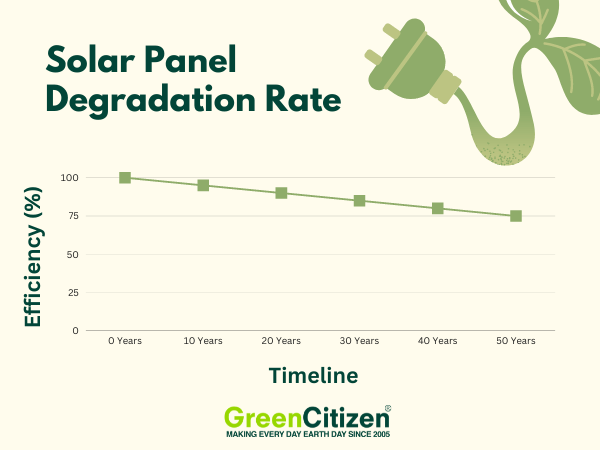
Factors Affecting Solar Panel Lifespan
When it comes to solar system technology, it’s important to factor in three key things that impact the lifespan.
1 – Manufacturer Quality
As with all other technology industries, solar panel manufacturers produce panels with different quality standards. The difficulty might seem like it’s in figuring out as a non-electrical engineer what high-quality solar panels are.
But there is a little trick you can use when choosing solar panels.
Take a closer look at the guarantee and warranty the different manufacturers offer. If a company makes big statements about their panels having a 25-year warranty with minimum production rates, then you’ve likely found a very high-quality product.
Ultimately, you won’t have to replace solar panels of such quality for many decades.
2 – Environmental Factors
How long solar panels last will also greatly depend on environmental factors around your home. Having lots of sunshine is obviously ideal, but if you live in a very hot climate, then the extreme heat could ultimately damage solar panels and other electrical components.
On the other extreme, storms, hurricanes, and heavy snowfall can all pose a significant risk to your solar panels that ultimately reduces their capacity for energy production.
It’s important to discuss such factors with the installation company, as there might be some considerations that could limit environmental damage.
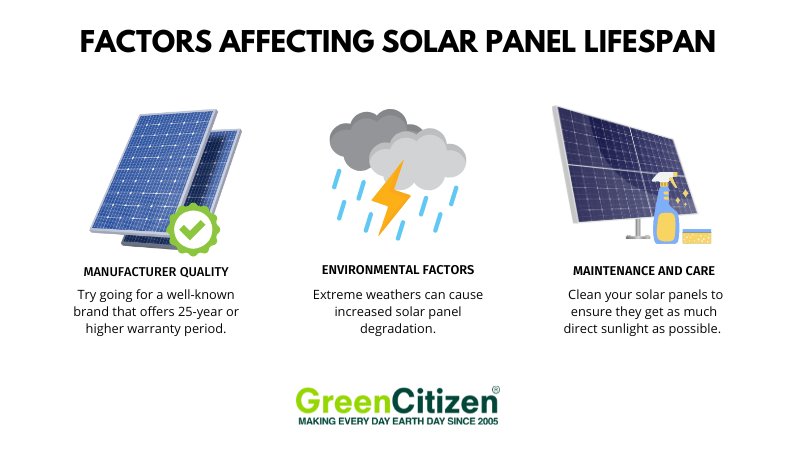
3 – Maintenance And Care
A solar power system is just like an engine in a car. And even though there really aren’t any moving parts, you need to put in some effort for basic maintenance and care.
I have a section on this below, but at the very least, you should regularly clean your solar panels to ensure they get as much direct sunlight exposure as possible.
Even with high-quality solar panels, you need to get them regularly serviced, just like you would with your car or gas heating system.
Personal Experience (Case Study)
I have had solar panels installed for four years now, and as a technology nerd, I’m constantly trying to figure out ways to compare energy production, especially after installing the home solar generator. In the first year, I took readings from the solar panel app on different dates and at different times for 1-hour time slots.
I also noted the weather conditions on whether it was sunny or cloudy. And I also took a UV meter reading to measure the intensity of the sun.
I know it’s nerdy, but none of this took much effort or time.
What I can tell you is that on a like-for-like basis, comparing a sunny day in early February from three years ago to this year, the degradation rate seems to be less than 0.5%. And for cloudy days in the summer, it’s also considerably less.
Signs of Solar Panel Aging
If your solar panels are only a few years old, then it’s not so important to understand what the signs of aging are. But it’s good to know these things if you think that it’s time to dispose of your old solar panels.
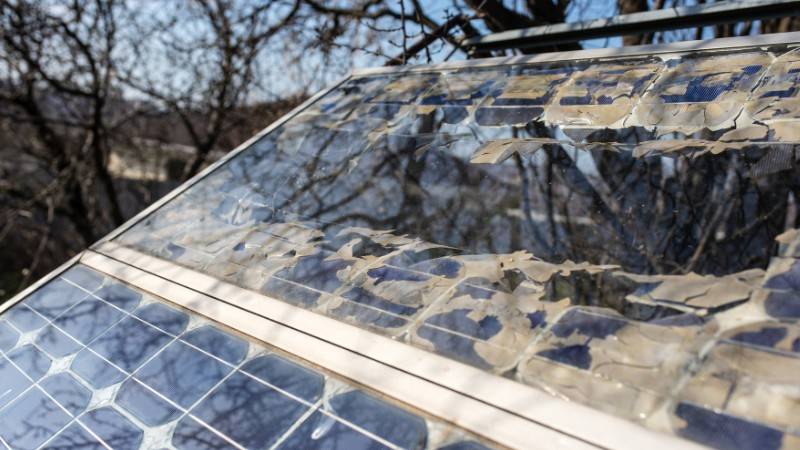
Declining Efficiency
I already mentioned above that solar panels will gradually reduce efficiency by about 0.5% per year. In my case, it has been a lot less, but it’s a good average to work on.
What you need to do to determine if your solar panels have significantly declined in efficiency is to pick a day in late spring or early summer when you have a clear sky for a few hours. When the sun reaches its highest point in the sky, check your solar panel system for the power output it’s generating.
Ideally, it should be too hot. Temperatures in the 80s would be ideal for such a test.
You then read the solar power output as the maximum it can achieve in ideal conditions. Also, make sure that you have cleaned any dirt or debris off the panels that might otherwise influence the efficiency.
Now you need to take that reading and compare it to the official output of those panels when they were new. You’ll find this in any documentation that came with the system, or you might need to contact the solar company for those technical details.
After 20 years, you would expect about a 10% drop in maximum output. But environmental factors and damage could cause that to go down faster. If you’re significantly below 70%, then it might be time to install new solar panels or maybe consider extending your system with newer solar cell technology.
Physical Wear And Tear
Solar panel systems can also get physically damaged in ways that would have an impact on the energy production rate. But it’s not just the solar panels that could become a problem.
Your system also includes solar inverters and many yards of cables. If these start to break down or experience physical damage, then it could impact an entire section of your solar panel setup.
This is usually something that you want to have a professional electrician or solar panel installer check out.
Not only is there a danger from the electricity that is generated, but you might also need to climb on a roof in order to physically inspect solar panels.
If you’ve noticed a sudden drop in output, or if your solar panel degradation rates are way higher than expected, then having such a maintenance check done is possibly the best way to eliminate such an issue.
Monitoring And Assessing Panel Performance
If you’ve installed a solar power system in the last five to ten years, then you should have a control panel and possibly even an app that provides a lot of performance-related data.
Most people only look at this to gauge how much electricity they have produced on different days. Or maybe they check how much output was fed into the grid to be credited by the utility company.
But these control panels should provide a lot of other data about the overall efficiency, and some even have a scale to rate the performance on. Keeping a regular eye on these data points will help you identify possible issues, especially if you see output gaps on sunny days.
My Experience With Solar Panel Aging
My own experience with installing solar panels at my home has shown that especially monitoring for dirt and physical damage is important.
I had one occasion where some debris during a storm had caused some cracks in the panel. Fortunately, this was covered by my home insurance as the output had significantly gone down due to this issue.
And for the declining efficiency, I suggest you start recording your output on different days of the year with different weather conditions. That way, you can compare your own data over the years and not just rely on the data in the app.
The other thing I would point out is that it’s important to have the panels regularly serviced and cleaned. If you can’t easily reach them to remove dust and dirt, then hire someone to do it. The added output could quickly pay for any servicing costs.
Maximizing Solar Panel Lifespan
There’s not a whole lot you can do about the solar panel degradation rate. This is normal and happens just like a car engine degrades, or your central heating boiler does. But there are still some things you need to consider to extend the lifetime and efficiency of your solar panels.
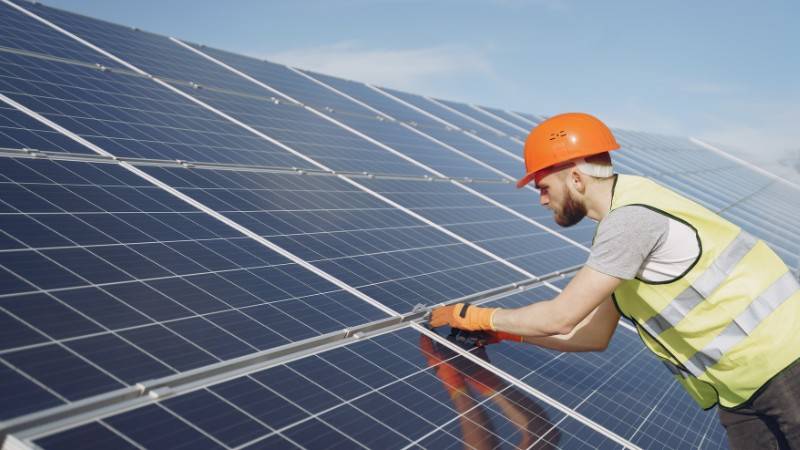
Installation Considerations
The number one consideration for solar panel installation is having it angled ideally towards the midday sun. This is when the sun intensity is at its highest and when your solar panels will achieve their highest performance.
But that location could also expose it to other environmental factors.
Even high-quality solar panels will have limited output if, for several months of the year, they are covered in leaves during fall. While you can’t do much about them blowing onto your panels, having a tree right next to them isn’t ideal.
You will also make your solar panels last longer if there is less danger of branches coming loose and damaging them.
You might also find that certain roof positions will result in shade covering the solar panels at different times of day, and that will severely limit their performance.
And you also have to talk to your solar panel installer about how they handle the positioning for optimum ventilation and airflow. These panels will get hot on sunny days, and you need to ensure that there is plenty of airflow around them. If this isn’t factored in, then you could end up with premature degradation and even damage.
Maintenance Tips
The first rule to consider is that solar panels require maintenance, and the most regular thing you need to do is regularly clean them. They don’t have to be polished, but leaves, dust, dirt, and bird droppings will build up and reduce the overall output.
Set a reminder on your phone, especially in summer when there isn’t regular rain, to check them from the ground. Then, use a water hose to spray them off, which should take care of most of the dirt.
The other thing you can do if you have easy access to solar panels is to use a soft brush to remove dust and dirt.
From my personal experience, I would also find out if the solar panel installation company offers an annual service plan. Solar panels last longer if you have someone physically inspect them and check all the electrical and electronic components.
Sometimes, these need replacing, just like parts on your car. And identifying such problems through regular maintenance is always better than having a catastrophic issue at a later stage.
Upgrading And Replacing Components
While the solar panels themselves shouldn’t require replacing for a very long time, there are other parts that can get damaged, or they might deteriorate under regular use.
What you also need to keep in mind is that new technology might be able to make your system more effective and efficient, and that doesn’t mean you have to replace solar panels. Plus, you should have a clear idea of how solar panels work. This will help you to identify the parts that need more frequent replacements.
There are plenty of components that won’t cost a lot and keep your system running even better.
The best time to explore this is when you have an electrician service your solar panels. Simply ask them if they know of any components that could make your system better or improve its lifespan.
Frequently Asked Questions (FAQ)
After ten years, solar panels may lose between 5% and 10% of their performance. The newest solar panels have a lower natural degradation, and this is something you can’t avoid. But it’s possible to limit the impact with regular care and maintenance.
After 25 years, solar panels could lose about 15% of their performance. With older panels, this degradation could be significantly more. But modern solar panels should only have a 0.5% annual rate of decline.
Some modern solar panels last 40 to 50 years, but you have to factor in a gradual performance degradation. After 50 years, this could be a 30% of performance loss, but after this much time, it depends on many environmental factors.
Yes, solar panels lose efficiency. This is known as the degradation rate of solar panels, and with the newest technology, it would be about 0.5% per year. That means after 20 years, you should still have 90% of the original performance.
Solar panels don’t weaken over time, but their performance goes down. The degradation rate of solar panels is about 0.5% per year, but this doesn’t come from the physical weakening of the actual solar panels.
Monocrystalline solar panels tend to be the best because of their extremely high-efficiency rating. This technology also has proven to make solar panels degrade less over time, giving them a longer lifespan.
Monocrystalline solar panels have the highest efficiency. These solar panels can achieve up to 22% efficiency, which will translate into a significantly higher electricity output in both sunny and cloudy conditions.
Conclusion
Now that you have a better understanding of how long solar panels last, it’s time to consider making such an investment for your home. You’ll be able to get a free consultation and assessment from pretty much all solar panel installation companies in your area.
This will give you an expected electricity output along with total installation costs. And by working out the lifespan of solar panels, you can see how high your return on investment will be.
Even in places with not the ideal amount of sunshine each year, you’ll be surprised how quickly your investment will have paid for itself.

